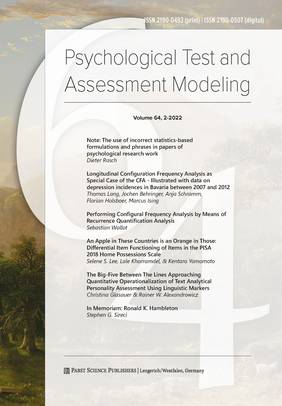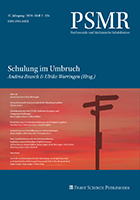Note: The use of incorrect statistics-based formulations and phrases in papers of psychological research work
Dieter Rasch
PDF of the full article
Longitudinal Configuration Frequency Analysis as Special Case of the CFA - Illustrated with data on depression incidences in Bavaria between 2007 and 2012
Thomas Lang, Jochen Behringer, Anja Schramm, Florian Holsboer, Marcus Ising
PDF of the full article
Performing Configural Frequency Analysis by Means of Recurrence Quantification Analysis
Sebastian Wallot
PDF of the full article
An Apple in These Countries is an Orange in Those: Differential Item Functioning of Items in the PISA 2018 Home Possessions Scale
Selene S. Lee, Lale Khorramdel, & Kentaro Yamamoto
PDF of the full article
The Big-Five Between The Lines Approaching Quantitative Operationalization of Text Analytical Personality Assessment Using Linguistic Markers
Christina Glasauer & Rainer W. Alexandrowicz
PDF of the full article
In Memoriam: Ronald K. Hambleton
Stephen G. Sireci
PDF of the full article
Note: The use of incorrect statistics-based formulations and phrases in papers of psychological research work
Dieter Rasch
Preamble
Due to acting regularly as a reviewer of submitted papers in severals journals of Psychology I often realize a hardly statistician correct approach of the authors when trying for statistical testing. Although, there are a lot of Psychologists in the scientific community who are very competent with respect to the issues given in the following, it once more seems worthwhile to advice others fundamentally in Statistics.
Dieter Rasch
University of Natural Resources and Life Sciences
Vienna, Austria
d_rasch@t-online.de
Longitudinal Configuration Frequency Analysis as Special Case of the CFA - Illustrated with data on depression incidences in Bavaria between 2007 and 2012
Thomas Lang, Jochen Behringer, Anja Schramm, Florian Holsboer, Marcus Ising
Abstract
The Configuration Frequency Analysis (CFA) by Krauth & Lienert (1973) was originally developed for the identification of cross-sectional types and syndromes of an array of discrete variables designated as configurations. However, a longitudinal CFA variant on arrays composed of repeated observations of a discrete variable was already discussed in the original publication. In later work, Lienert chose to call this variant configuration trajectory analysis (German: Konfigurationsverlaufsanalyse, KVA), while recent text books introduced the term Longitudinal CFA (L-CFA). The L-CFA is characterized by a robust person-oriented analysis of trajectory types and provides a descriptive overview on types and antitypes in a longitudinal data set. We are illustrating the utility of the L-CFA in two large data sets of the health insurance company AOK Bayern testing the hypothesis of increasing depression risk during the time period between 2007 and 2012 by searching for typical and antitypical trajectories of depression incidence rates among Bavarian citizens.
Keywords: Configuration Frequency Analysis, person-oriented approach, longitudinal design, depression, somatic disorders
Marcus Ising
Max Planck Institute of Psychiatry
Kraepelinstr. 2
80804 Munich, Germany
ising@psych.mpg.de
Performing Configural Frequency Analysis by Means of Recurrence Quantification Analysis
Sebastian Wallot
Abstract
Recurrence Plots (RPs) were developed at the end of the 1980’s as visualization tools for complex dynamics exhibited by time series measures from physical and dynamic systems. At the beginning of the 1990’s RPs were further developed into Recurrence Quantification Analysis (RQA), which allowed for numerical characterizations – and analyses – of such time series. In the past couple of years, RQA has been further developed to analyze coupling between two time series, the dynamics of multivariate time series, and can be used to derive correlations between two multivariate time series. The aim of the current paper is to expand on another line of development, which is to extend recurrence-based techniques to the analysis of sample data – here, specifically to use RQA in order to perform the classical or so-called first-order Configural Frequency Analysis (CFA), as developed by Lienert in the 1970’s. First, RQA and some of its extensions will be introduced, that allow to properly deal with multidimensional categorical time series or sequences. Then, we will combine these existing techniques to create a framework that can perform a CFAtype of analysis, based on a bootstrap approach.
Keywords: Configural frequency analysis; recurrence quantification analysis; multidimensional data; categorical data
Sebastian Wallot
Leuphana University of Lüneburg
Universitätsallee 1
21335 Lüneburg,Germany,
Sebastian.wallot@leuphana.de
An Apple in These Countries is an Orange in Those: Differential Item Functioning of Items in the PISA 2018 Home Possessions Scale
Selene S. Lee, Lale Khorramdel, & Kentaro Yamamoto
Abstract
In the Programme for International Student Assessment (PISA), students’ socio-economic status (SES) is measured with parents’ education, parents’ occupation, and home possessions. An important assumption in comparative research using these SES scores is that they are comparable across countries, an assumption which needs to be tested. This study focuses on the home possessions (HOMEPOS) scale, a component of PISA’s SES scale, and finds that some items in the scale function differently across countries when measuring family wealth – in other words, they exhibit differential item functioning (DIF). The study also finds that there are associations between DIF and a country’s level of economic development, geographic location, and socio-cultural characteristics of a group (such as language and religion). This paper provides several recommendations that can potentially improve the comparability of the HOMEPOS scale across countries in the future, and by extension, the cross-country comparability of the SES scale of PISA. This is an important contribution, considering the increasing diversity of countries that are participating in PISA as well as the increasing focus on educational equity in many countries.
Keywords: differential item functioning (DIF), home possessions (HOMEPOS) scale, socioeconomic status (SES), Programme for International Student Assessment (PISA), international large-scale assessment (ILSA)
Selene S. Lee, PhD
Educational Testing Service
660 Rosedale Road
Princeton, NJ 08541, USA
slee003@ets.org
The Big-Five Between The Lines
Approaching Quantitative Operationalization of Text Analytical Personality Assessment Using Linguistic Markers
Christina Glasauer & Rainer W. Alexandrowicz
Abstract
Personality assessment based on questionnaires can be distorted due to social desirability, deliberate faking, or unconscious factors like false memories. Using objective measures of personality can counteract these distortions as the intention of the assessment usually is not apparent. Present study aims to develop and examine an objective measure of personality based on quantitative text analysis. We use linguistic markers that have been shown to be related to the Big-Five personality traits in existing research and define a linguistic model of personality based on these findings. The linguistic model’s usefulness in personality assessment is investigated by analyzing reliability and validity of the proposed procedure. After gathering personal texts and conventional measures of the Big-Five of N = 124 individuals, we processed text using LIWC and analyzed data in a structural equation modeling approach. Especially the linguistic scales of the dimensions Extraversion, Conscientiousness, and Agreeableness showed satisfying model fits. Neuroticism, Conscientiousness, and Openness showed promising convergence with traditional measures of personality. The results emphasize the potential of the quantitative text analytical approach to personality assessment and provide indications for future adaptions of the instrument.
Keywords: Personality Assessment, Speech, LIWC, Big-Five, Linguistic Markers
Christina Glasauer
Karl Popper Kolleg SEEROSE Universität Klagenfurt
Universitätsstraße 65-67
9020 Klagenfurt, Austria
christina.glasauer@aau.at
In Memoriam: Ronald K. Hambleton
Stephen G. Sireci
University of Massachusetts Amherst, USA
Psychological Test and Assessment Modeling
Volume 64 · 2022 · Issue 2
Pabst, 2022
ISSN 2190-0493 (Print)
ISSN 2190-0507 (Internet)























